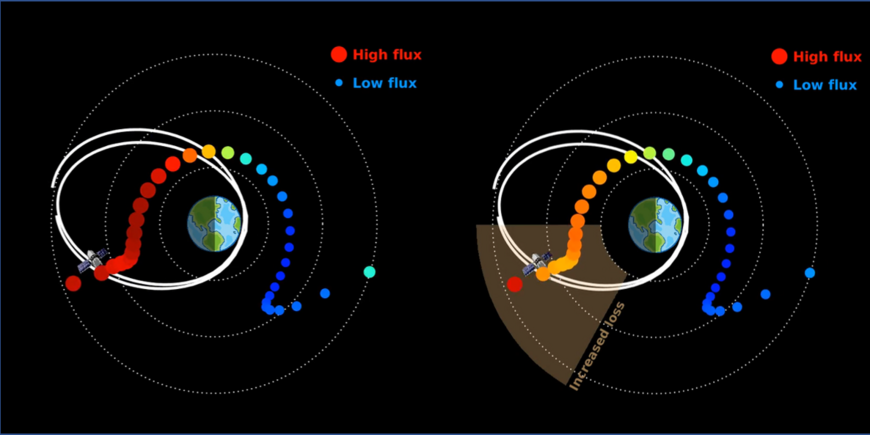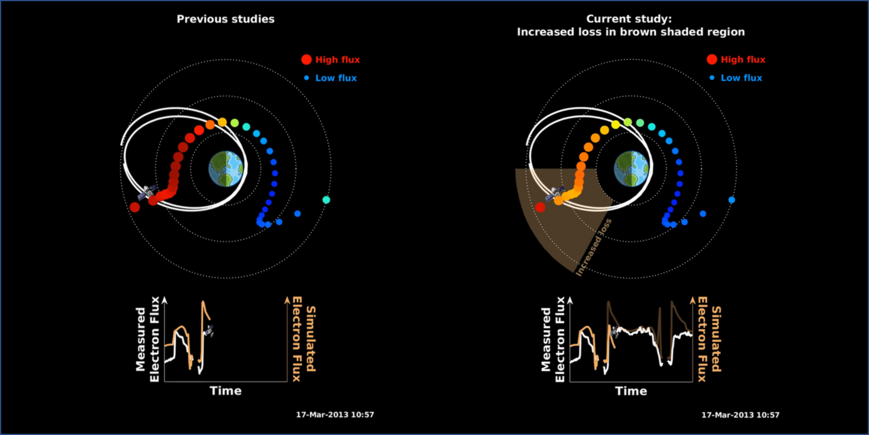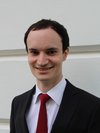Summary
Charged particles from space are captured by the Earth's magnetic field. They then flow in a circular path around the Earth, forming what is known as a ring current. Knowledge of its dynamics is important because it in turn affects the Earth's magnetic field and atmosphere and can create dangerous conditions for satellites. In particular, the behaviour during geomagnetic storms caused by increased solar activity is not yet fully understood. Models used for this purpose have so far systematically overestimated the strength of the ring current. Researchers led by Bernhard Haas and Yuri Shprits from the GFZ German Research Centre for Geosciences have shown this in a study published in the journal Nature Scientific Reports. They analysed the particle trajectories during geomagnetic storms and identified a hitherto unrecognised particle loss process through scattering by so-called plasma waves.
The ring current and its effects
Space is filled with the interplanetary medium, a mix of protons, electrons and other charged particles emitted by the Sun, among others. Some of these charged particles are captured by the Earth's magnetic field. They then flow as a so-called ring current on a circular path in the equatorial plane at a distance of a few Earth radii around the Earth.
Depending on solar activity, the ring current can change dynamically. It is important to know this as precisely as possible because the ring current has various effects on the Earth and its surroundings: It can cause dangerous surface charging effects on satellites, which can significantly affect their operation and functioning. Ring current electrons can enter the atmosphere via scattering processes and contribute to the destruction of ozone through the formation of nitrogen oxides. And last but not least, the ring current can weaken the Earth's net magnetic field. In order to be able to study the magnetic field in the Earth's interior as precisely as possible, external influences such as that of the ring current must be decoupled mathematically.
The ring current has long been able to be measured in space and from Earth. Such measurements were first made by Alexander von Humboldt in Berlin in 1806. He also coined the term “magnetic storm” for the changes in the Earth's magnetic field caused by increased solar activity.
Effects of geomagnetic storms on the ring current
Although the ring current has been studied scientifically for decades – both with measurements and via modelling and computer simulation – it is still not fully understood how it changes during geomagnetic storms. This is because there are many different processes that contribute to its behaviour on different time scales.
New modelling approaches show particle loss
One of the main features of a geomagnetic storm is an increased particle flux in the ring current. However, the number of electrons was systematically overestimated by previous models, especially at the beginning of the storms, on the night side of the Earth. This was shown by scientists led by Bernhard Haas and Yuri Shprits from the GFZ German Research Centre for Geosciences and the University of Potsdam in a study published in the journal Nature Scientific Reports. As the cause, they identified particle loss processes that had not been taken into account until now.
The starting point for the researchers' analyses were strong discrepancies between model predictions and measurements of the Earth's inner magnetosphere during strong geomagnetic storms.
For more detailed investigations, the GFZ team looked at a special magnetic storm event, namely the so-called St. Patrick's Day storm of 17 March 2013, which has already been studied on several occasions and shows a clear distinction between strong and weak geomagnetic activity.
Searching for causes for lower particle flux in the ring current
Basically, there is a permanent particle fluctuation in the ring current: new particles are captured, others are ejected. The position in the ring current also plays a role here, i.e. whether one looks at the day side facing the sun or the night side facing away from it. This is because the Earth's magnetosphere is very different in each case.
The researchers first clarified that the cause of the observed overestimation of the number of electrons was not in the modelling of the source processes. Instead, they found loss processes that had not been taken into account by previous models.
For this purpose, they analysed the paths of electrons after their entry into the ring current. With the help of simulation calculations, they found out that some of the electrons are most likely scattered out of the ring current back into the atmosphere through interaction with so-called plasma waves. Plasma is a state in which positively and negatively charged particles predominate. For example, fluctuations in particle density give rise to plasma waves, which are accompanied by fluctuating electric and magnetic fields and can thus interact with charged particles again.
Summary and outlook
“These processes have not been captured with sufficient accuracy by previous models of the ring current. With our approach, we were able to empirically quantify electron losses that had not been considered before and show that they must be extremely strong. We have identified two types of plasma waves that could be responsible for the scattering processes. However, the physical mechanism is not yet fully understood and will be the subject of future studies. An exact localisation of the loss processes in the ring current is not possible with our method, but our calculations indicate that the processes take place in the ring sector, which must be before midnight”, sums up Bernhard Haas, first author of the study and PhD student at the GFZ. (See the picture and the video above).
Yuri Shprits, head of Section 2.7 “Space Physics and Space Weather” at the GFZ and Professor at the University of Potsdam, adds: “This is an important step towards a better understanding of the dynamics of particles in this region of space and helps us to better model and predict the behaviour of the ring current during geomagnetic storms. This, in turn, is a prerequisite for protecting satellites from the corresponding damaging effects, as well as for better understanding the Earth's magnetic field in its interior and the effects of these particles on the atmosphere and thus also on the climate.”
Since the ring current also affects the atmosphere, this study contributes to Topic 1 “Atmosphere in Global Change” and Topic 3 “Living on a Restless Earth – Towards Forecasting Geohazards” of our research programme “Changing Earth – Sustaining our Future” of the Programme-oriented Funding PoF IV of Helmholtz Earth and Environment.
Original publication:
Haas, B., Shprits, Y.Y., Allison, H.J. et al. A missing dusk-side loss process in the terrestrial electron ring current. Sci Rep13, 970 (2023). DOI: 10.1038/s4159-023-28093-2












![[Translate to English:] Torsten Sachs in front of a climate station on a field](/fileadmin/_processed_/3/9/csm__TorstenSachs_bearbeitet_GS_4a1365ef84.jpeg)

![[Translate to English:] left image flood at the Ahrtal: image from above, several houses are flooded; left image:: Heidi Kreibich;](/fileadmin/_processed_/4/4/csm_Bild2_9af0130e9f.png)



![[Translate to English:] Start der Vega Rakete](/fileadmin/_processed_/6/4/csm_20231201-kachel_Vega-VV23-launch_ESA-CNES-Arianespace_706716b68c.jpeg)









![[Translate to English:] Poster exhibition at the Brandenburg Hydrogen Day at the GFZ, some participants in the foreground](/fileadmin/_processed_/6/5/csm_Erster_Brandenburgischer_Wasserstofftag_GFZ_402fcec95e.jpeg)
![[Translate to English:] Group picture of the participants](/fileadmin/_processed_/9/4/csm_20231108_CAWa-Workshop-Tashkent_Gruppenbild_99ea779d8a.jpeg)

![[Translate to English:] [Translate to English:] Hörsaal](/fileadmin/_processed_/e/6/csm_H%C3%B6rsal_e21ac645fb.jpeg)


![[Translate to English:] The Delegations in the Historic Library on the Telegrafenberg. In the back there are from left to right, the Dutch Ambassador for Germany, Ronald van Roeden, the Dutch Minister for Education, Culture and Science, Robbert Dijkgraaf and the scientific director of the GFZ, Susanne Buiter.](/fileadmin/_processed_/d/b/csm_Kachel-2_9eba4b4212.jpeg)

